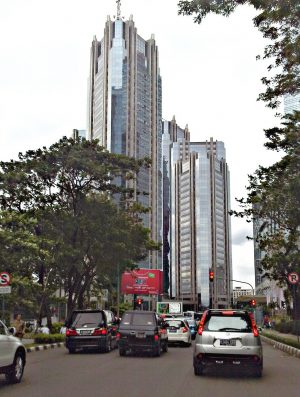On January 15, 2018, the Indonesia Stock Exchange collapsed – literally. The Exchange is located in a high-rise in Jakarta’s business district, and as a group of schoolchildren touring the building gathered on the mezzanine it suddenly collapsed. Fortunately, everyone survived, though dozens had to be hospitalized. The collapse was blamed on a combination of shoddy construction and wear and tear – the kind of structural problems that can usually be caught by routine inspections and strict building code compliance.
But the event highlighted, in an unusually direct way, the link between two important aspects of Indonesia’s economic ambitions: the deepening of its domestic financial markets against the backdrop of an often unreliable regulatory environment. If you push too hard for growth without having sound regulatory architecture in place, it can lead to preventable disasters. This is something international investors are keenly aware of, and the issue is especially relevant now as the stock market fell by more than 5 percent last week.
Coordinating Economic Minister Airlangga Hartarto suggested that Jakarta Governor Anies Baswedan was to blame for re-imposing social restrictions on the capital. This was followed by a piece in Reuters claiming that Southeast Asia was “slipping to the bottom of global investors’ shopping lists” and singling out Indonesia as a particularly weak performer. But tracking short-term fluctuations in the Jakarta Composite Index, particularly during this period of volatility and uncertainty, risks missing out on some deeper things going on at the exchange, while glossing over its more critical structural vulnerabilities.
The first thing to do is place all of this in the proper perspective. The Indonesia Stock Exchange is small. Created from the merger of the Jakarta and Surabaya exchanges in 2007, as of 2019 there were only 668 listed companies with a market capitalization of 7,265 trillion Indonesian Rupiah, roughly $490 billion at current exchange rates. The New York Stock Exchange, by comparison, has a market cap of $30 trillion. Moreover, only 1.1 million people actually invested in stocks in Indonesia during 2019, which suggests the exchange’s short-term performance won’t have a big impact on the real economy – simply because not that many people are exposed to it.
But while the exchange may be punching below its weight, relative to the size of Indonesia’s economy it has been growing rapidly, adding 147 new listed companies in just the last five years and reaching 55,000 active daily investors in 2019. The bond market has also been gathering steam, with the volume of government bonds increasing by 37.8 percent and corporate bonds by 18.6 percent from 2018 to 2019. This did not happen in a vacuum, but is part of a larger vision for the economy. When President Joko “Jokowi” Widodo took office in 2014, he pushed for innovative ways to finance his expansive infrastructure plans.
There was an understanding that Indonesia needed to deepen its domestic financial markets in order to underwrite economic growth and leverage capital more efficiently. The local bond market is doing some especially heavy lifting now, as the government is running a larger than normal deficit to combat COVID-19. The increased pace of new listings, the growing rate of investor participation and the activity in the bond market are all signs that Jokowi’s strategy has in the aggregate been working more or less as planned.
The real question is whether the pace of this growth is sustainable. It is worth asking whether a regulatory system that cannot keep a mezzanine from collapsing in a high profile office building can really engineer and then monitor the complex financial architecture necessary to ensure the smooth functioning of its capital markets. On this account there is already cause for concern, with a number of investment companies known to have engaged in fraud and mismanagement. That needs to be rigorously policed in the interest of maintaining credibility.
It seems likely that Indonesia’s financial markets will return to robust growth in the near future. What is less clear is whether the regulatory authorities, and even the regulations themselves, are up to the task of ensuring a stable and fair market as more money begins to flow into the exchange. This is a more complex consideration than tracking fluctuations in the benchmark composite, and the answer is also more important. If Indonesia’s regulatory architecture can’t keep pace, then the next collapse might be of a different kind altogether.

































